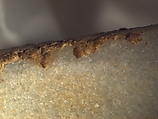On loan to The Met The Met accepts temporary loans of art both for short-term exhibitions and for long-term display in its galleries.
Marble female figure
Technical analysis: Multiband imaging, raking light examination, optical microscopy, Raman spectroscopy, X-ray fluorescence spectroscopy
The figure, complete and intact except for two small modern fills on the face and shoulder, is carved from a fine-grained (maximum grain size ≈ 1 mm) heteroblastic banded marble that is consistent with that of the Cyclades, possibly from the islands of Ios or Naxos. The surface is heavily weathered and shows a diffuse and uniform dissolution of calcite grains, which has enhanced the banded structure of the marble. This calcite weathering, together with a very thin, yellowish patina rich in iron-oxides, are homogenously distributed, suggesting the possibility that modern cleaning and chemical treatments may have altered the original surface of the stone. Broad areas of orangish accretions on the back seem to have been cleaned off the front. Scattered bits of red and blue color appear to be modern, since many are on top of the accretions on the reverse.
The figure’s U-shaped head is relatively large and forms an arc in profile, the curve of which is accentuated by the long nose. The front of the figure is very flat, with wide-spaced breasts placed high on the chest and narrow arms folded in the conventional left-over-right position. The pubic triangle is in ted by an incised lines across the lower abdomen and at the top of each thigh. The deep cleft separating the legs pierces the incised triangle above. The thighs and calves are rather short and flat on top; the feet have pronounced heels and slightly arched soles. Both the fingers and toes are articulated. As is true for most Late Spedos type figures, the length of the legs to below the heels are separated by a continuous wedge-shaped cutting that is deeper on the front than the back, and only slightly perforated between the calves. The spine on the back is only lightly marked and does not connect with the angular lines at the back of the neck.
Although no ancient pigments have been preserved, ghost eyes have been identified on both sides of the face, as well as a possible ghost image of a tendril of hair on the proper left side of the back of the head. A prominent raised band that runs diagonally across the upper back lacks explanation, but is a feature seen on other Cycladic figures.
Cycladic figures preserved in their entirety, without any missing parts or fractures at vulnerable points, are quite rare. The figure here is exceptional, as it is not only virtually intact, but also well carved and in good condition. Pat Getz-Gentle attributed the work to the Bastis Master, named for the collector, Christos Bastis, who gifted another figure by the same sculptor to The Met in 1968 (68.148).
The figure is part of a group of objects acquired by Leonard Stern that came from the Christoph Bernoulli collection.
Alexis Belis, Dorothy Abramitis, Federico Carò
Due to rights restrictions, this image cannot be enlarged, viewed at full screen, or downloaded.
This artwork is meant to be viewed from right to left. Scroll left to view more.












